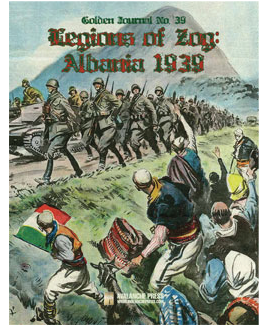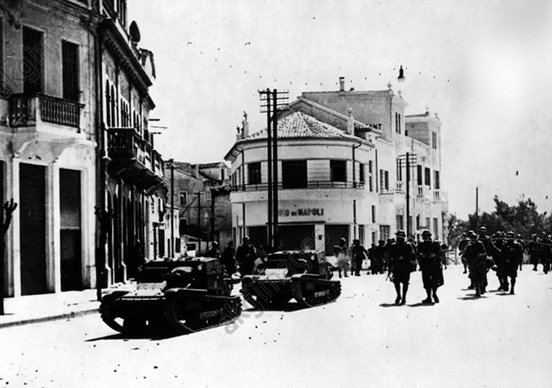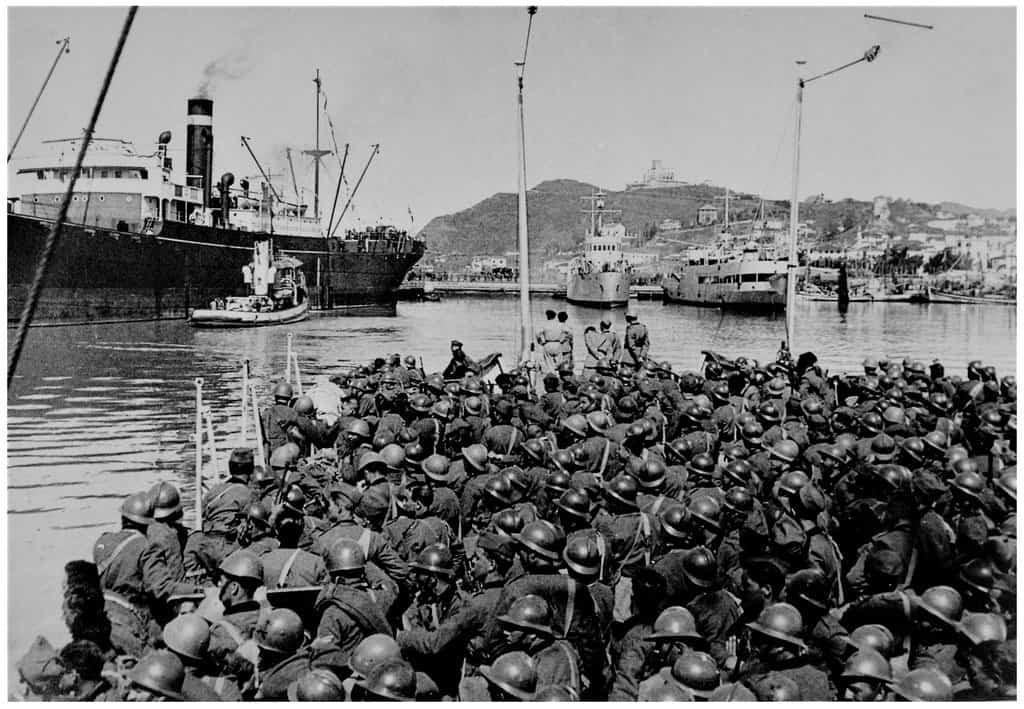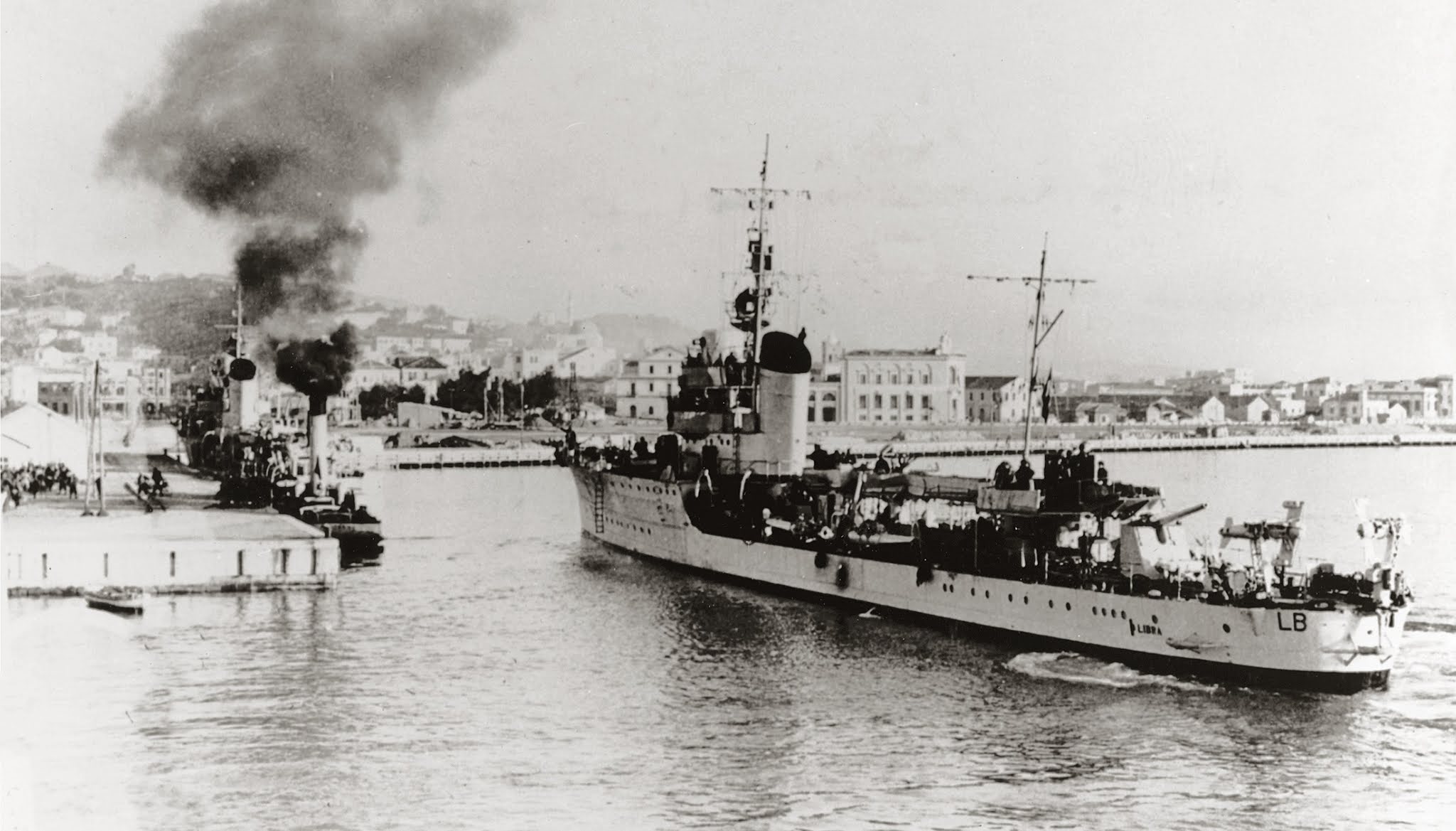| Golden Journal No. 39:
Legions of Zog
Invading Albania
by Mike Bennighof, Ph.D.
March 2022
 Ten days after German troops rolled into Prague on 15 March 1939, the Italian Minister to Albania, Francesco Jacomoni, presented King Zog I with an eight-point set of demands that effectively stripped Albania of her independence. Zog kept the demands to himself, not sharing them with any of his ministers or advisors, and stalled for time. By this point Queen Geraldine was nine months pregnant with Zog’s first child, and due to deliver at any time. Ten days after German troops rolled into Prague on 15 March 1939, the Italian Minister to Albania, Francesco Jacomoni, presented King Zog I with an eight-point set of demands that effectively stripped Albania of her independence. Zog kept the demands to himself, not sharing them with any of his ministers or advisors, and stalled for time. By this point Queen Geraldine was nine months pregnant with Zog’s first child, and due to deliver at any time.
“There is, above all, a fact on which I am counting: the coming birth of Zog’s child,” Ciano told his diary. “Zog loves his wife very much, as well as his whole family. I believe that he will prefer to insure his dear ones a quiet future.”
Meanwhile, Italian mobilization ran into continued problems; Army chief of staff Alberto Pariani, a notable boot-licker even by the standards of Mussolini’s cronies, admitted that the invasion force was not yet ready. So, Ciano delivered a second, slightly softer ultimatum with four points. Zog more or less rejected them, but asked for more time to consult his ministers and that Pariani, who he knew personally from the Italian general’s stint as military attaché to Albania, be sent to negotiate. Jacomoni re-iterated that the ultimatum would expire at noon on 6 April.
Zog spent the final days of his kingdom appealing to foreign powers for at least diplomatic if not military intervention. Both the Great Powers and the Balkan states declined to become involved. British Prime Minister Neville Chamberlain reacted by taking a 10-day holiday in Scotland. By invading on Good Friday, the Italians would have three days to secure the country before most other governments even noticed.

Italian tanks and troops on the streets of Durrës, 7 April 1939.
Zog also called for anti-Italian demonstrations in Albanian towns and cities, which brought out crowds at least claiming to be eager to fight the would-be invaders. Zog declined their demands for arms, apparently fearing that any weapons issued would be turned against his regime instead of the Italians.
Meanwhile, the Italians scrambled to put together an expeditionary force. Pariani only received word of the invasion on 29 March, and the invasion force commander, Alfredo Guzzoni, was told on the evening of the 31st. Guzzoni madly drafted landing plans while on the train to Brindisi, the invasion embarkation port; that he assembled an invasion force and got it to sea on time was an amazing, if absolutely unnecessary, improvisation.
The four initial landings took place at the ports of Durrës (Durazzo), Shëngjin (San Giovanni di Medua), Vlorë (Valona) and Sarandë (Santi Quaranta). Three Bersaglieri battalions and two companies of the San Marco Marine Regiment landed at Shëngjin, with Shköder in northern Albania as their objective. Three more battalions of Bersaglieri and one of Blackshirts came ashore at Vlorë, tasked with occupying the inland city of Fier as well. At Sarandë, in far southern Albania just across a narrow strait from the Greek island of Corfu, two battalions of Bersaglieri, two companies of San Marco marines and a group of tankettes would land and secure the port against any Greek attempts to seize disputed border areas.
The main effort would come at Durrës. Five battalions of Bersaglieri, one of regular infantry and two light tank battalions would land from ships and march on the capital, Tirana. Once the airfield there had been secured, two battalions of the elite 21st “Granatieri de Sardegna” Division would be inserted by air. On the following day, most of the 23rd “Murge” Infantry Division would land at Durrës, along with two battalions of horsed cavalry.

Italian Bersaglieri come ashore at Durrës, 7 April 1939. Note that many in this elite unit are wearing World War One era Adrian helmets.
Opposing them, the Royal Albanian Army fielded seven understrength battalions of infantry and one of Royal Guards, plus about 3,000 militarized police. Over the preceding year, Ciano had inserted more and more Italian officers and NCO’s in leadership positions for “training” purposes and eased out Albanians from posts commanding troops. When the invasion began, the Italians departed and left the troops without any direction. Only the national police – the Gendarmerie – attempted organized resistance.
On the Italian side, things began to go wrong almost immediately. Durrës had been selected as the focal point of the invasion, and the port had been rebuilt during the 1930’s by Italian contractors. No one apparently informed Guzzoni or Admiral Arturo Riccardi, commanding the naval component, that Durrës had no deep-water off-loading capabilities. Troops, vehicles and supplies would have to be laboriously winched onto lighters and brought to shore, a slow and cumbersome process.
The Royal Albanian Army did not fight for Durrës, but the local gendarmerie commander, Maj. Abaz Kupi, led his own men and as many soldiers as he could round up in a counter-attack supported by the two guns of a coastal defense battery. Just what happened next is disputed; the Italian official history lists twelve men killed in action, while Bernd J. Fischer, court historian to Zog’s son Leka, makes an absurd claim that 700 Italians died on the first day at Durrës.
Albanian troops also fought back at Shköder, but the Italians overcame resistance there by the following morning. Guzzoni landed with the first wave at Durrës and led his troops onward to the capital; the advance stalled for six hours as vehicles were brought ashore so that the Italians could have tanks leading their procession.

The Italian torpedo boat Libra enters the port of Durrës, 7 April 1939.
Zog himself sent his wife and new-born son, Leka, to the Greek frontier in an ambulance even before the Italians started landing. He gave a stirring speech over the radio, calling on Albanians to resist to their last drop of blood. The words were in vain, as few Albanians owned radios, and not at all heartfelt, as Zog soon followed Geraldine into Greece.
At least Ciano had his valor recognized – he and his assistant flew over Albania in his private plane, claiming this as participation worthy of a campaign medal. The Albanian Air Force, consisting of 15 men and two unarmed L.47 Albatros trainers, did not take to the air against the Italians. Albania’s Air Force had one working airfield in April 1939, a grass strip 22 kilometers west of Tirana with no infrastructure and a tendency to flood. Tirana did have a civilian airport, with an Italian airline holding a monopoly on air travel.
Years of Italian penetration had assured that Zog’s battalions would not fight. After the Italians had secured the capital and crowned Vittorio Emaneule as King of the Albanians, they disbanded the Royal Army but kept the gendarmerie (under new leadership, of course). Zog’s old foe Shefqet Vërlaci headed up a puppet government, and the battalion-sized Royal Guard – who one might think would have included Zog’s most devoted loyalists – was one of the few Albanian units retained after the Italian conquest.
The Italians had about a year and a half of relative peace, before the invasion of Greece in October 1940 fully exposed their incompetence and corruption. Resistance steadily grew, until large parts of Albania hosted energetic partisan movements. But that’s another story.
The Golden Journal is only available to the Gold Club (that’s why we call it the Golden Journal). If you want your Albanians, you need to join now.
Click here to join the Gold Club.
See your Gold Club Insider newsletter for ordering information.
Sign up for our newsletter right here. Your info will never be sold or transferred; we'll just use it to update you on new games and new offers.
Mike Bennighof is president of Avalanche Press and holds a doctorate in history from Emory University. A Fulbright Scholar and NASA Journalist in Space finalist, he has published a great many books, games and articles on historical subjects.
He lives in Birmingham, Alabama with his wife, three children, and his dog Leopold, who is a good dog.
Want to keep Daily Content free of third-party ads? You can send us some love (and cash) through this link right here.
|
